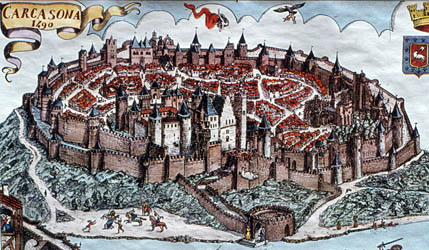The Pre-Roman Period
Carcassonne lies on what must have been an important communication link, even in pre Roman times. The route between the Atlantic ocean and the Mediterranean Sea falls naturally between the Black Mountain to the North and the the high Pyrenees to the South.
Archaeological excavations have revealed the remains of a fortified town (or oppidum) here, including huts with walls made of clay mixed with stones and straw, and with tiled roofs.
These have been dated to the 6th century BC, and were probably attributable to the Iberian peoples.
About 300 BC a Celtic tribe, called the Volcae-Tectosages, came from Central Europe east of the Danube.
They fought and defeated the indigenous Iberians and settled in the place we now know as Carcassonne. Little is known of them.
Some of the Celts of the Languedoc allied themselves with
Hannibal, as he made his way north from Spain to the Alpes,
on his way to meet the Romans in battle on their own ground.
For Hannibal's visit to the Languedoc with his elephants,
click here
Within a few years the Romans controlled the area. For more about the Romans in Carcassonne see below.
The Gallo-Roman Period
By 122 BC the Romans were in control of the Narbonnais area and settled in Carcassonne.
By 70 BC Roman Carcassonne was classed as a city.
The first stone walls of Carcassonne date back from this period.
There is little outward evidence of it, but if you walk around the lices between the two sets of city walls, in places where the inner wall has crumbled, you can see among the rubble in-fill small cordons of red bricks dating from this period.
Characteristic of the period are zigzag walls, punctuated by towers, both designed to withstand battering, to which straight walls were vulnerable.
In 350, the Francs took the city, but it was quickly re-taken by the Romans.
The Visigothic Period
The fourth century brought great instability as the Roman Empire crumbled.
The Visigoths were the next to arrive in the Languedoc. Despite its newly reinforced city walls, Carcassonne fell to them in AD 436.
A walled city was built in the 5th century by Euric I, King of the Visigoths. Under their Christian king Theodoric, they controlled what we now know as Provence, Aquitaine and the Languedoc (Septimania).
The Visigoths were not considered great builders. They did however maintain the walls, copying the Gallo-Roman art and style. For this reason it is not easy differentiate Gallo-Roman constructions from the Visigothic ones. (throughout the Languedoc, many Gallo-Roman constructions were wrongly attributed in the nineteenth century to the Visigoths).
In 508, the Franks reappeared. Under Clovis they launched an attack against the Visigoths. They took the city of Toulouse, and Gondebaud, king of the Burgondes, was given the task of taking Septemania, but he failed to capture Carcassonne. Although Clovis succeeded in unifying most of Gaule, he could never control Septimania without Carcassonne - its great defensive gateway.
Carcassonne and Septamania remained Visigothic until they fell to the Moors (Saracens) in 725.
Saracens

 Early
in the 8th century, the Saracens crossed the Pyrenees from
the Iberian peninsula and moved northwards, taking Carcassonne
in 725 AD. They renamed the city Carchachouna.
Early
in the 8th century, the Saracens crossed the Pyrenees from
the Iberian peninsula and moved northwards, taking Carcassonne
in 725 AD. They renamed the city Carchachouna.
Franks
In 759 under Pepin the Short, the father of Charlemagne, the Saracens were driven out of Septimania and back over the Pyrénées. (A very distorted and anachronistic version of the siege provides the famous story of Dame Carcas).
The Francs introduced the Germanic tradition of building in wood.
Some authorities believe that a wooden palisade would have defended of the enceinte (stone wall), but no trace has been found - and the benefits of defending a stone wall with a wooden one are not obvious.
The defensive system of the Roman fortification did not change much. The means of attack started to improve and the first machines of war since Roman times appeared.
The Medieval Period

![]() Carcassonne
and the area around it, the Razes, now became part of the
County of Barcelona. In 1082, Bernard Aton Trencavel,
Viscount of Albi, Nimes and Béziers was proclaimed Viscount
of Carcassonne.
Carcassonne
and the area around it, the Razes, now became part of the
County of Barcelona. In 1082, Bernard Aton Trencavel,
Viscount of Albi, Nimes and Béziers was proclaimed Viscount
of Carcassonne.
For over a century, between 1082 and 1209 the city of Carcassonne enjoyed tremendous influence under the Trencavels, a family closely related to the family of St-Gilles, Counts of Toulouse.
The Trancevals were Counts of Albi, Carcassonne, the Razés, Béziers and Nîmes, but they ceded their possessions for political reasons to the King of Aragon and recieved them back as Viscounts. At this time Carcassonne saw great prosperity: Taxes from merchants sometimes reaching half the value of the products.
Two boroughs grew up outside the city called Saint-Michael and Saint Vincent. The city was then divided into 16 châtellenies. This was a common feudal practice by which the city was divided up between senior vassals, each of whom was responsible for part of the defences - typically a stretch of wall and one or two towers. Important construction works were undertaken on several points including the "Count's Castle".
One can easily recognise parts of the masonry dating back to this period. Their characteristics are a rough construct ion with a facing of yellowish sandstone (generally 0.15 to 0.25 m in height and 0.20 to 0.30 m wide.) The Visigothic towers, partly ruined through undermining during the various battles over the centuries, were consolidated and raised in height. This consolidation work was undertaken before the crusader wars against the Cathars which started in 1209. Some key events during the Middle Ages:
- 1096: Pope Urbain II blessed the materials to be used to build the Church of Saint-Nazaire.
- 1130: Construction of the Chateau Comtal, and the restoration of the Gallo-Roman walls.
- 1209 (August 1-15thst): Raimon Roger Trencavel is besieged during the Crusader wars against the Cathars.
- 1240: Raimon Trencavel attempted unsuccessfully to win back the city of Carcassonne. The inhabitants of the Saint-Vincent were punished for their support. They were burnt and the old borough destroyed.
The Crusader Wars against the Cathars

![]() For over a century, between 1082 and 1209 the city of Carcassonne
enjoyed tremendous influence under the Trencavels
, a family closely related to the family of St-Gilles, Counts
of Toulouse. The Trencavels were Counts of Albi, Carcassonne,
the Razés, Béziers and Nîmes,
but they ceded their possessions for political reasons to
the King
of Aragon and recieved them back as Viscounts.
For over a century, between 1082 and 1209 the city of Carcassonne
enjoyed tremendous influence under the Trencavels
, a family closely related to the family of St-Gilles, Counts
of Toulouse. The Trencavels were Counts of Albi, Carcassonne,
the Razés, Béziers and Nîmes,
but they ceded their possessions for political reasons to
the King
of Aragon and recieved them back as Viscounts.

![]() The medieval period also saw the rise of the Cathar
religion. Raymond-Roger
Trencavel, Viscount of Carcassonne was sympathetic to
this religion and offered Cathars
refuge on his lands. The young Count was not
wise enough to enter into the alliance offered by his uncle,
Raymond
VI of Toulouse, nor to distrust the duplicity of the
Catholic Crusaders. Consequently, he ended up
dying a miserable death in his own prison at the age of
24, a scandal at the time which is not forgotten even now.
The medieval period also saw the rise of the Cathar
religion. Raymond-Roger
Trencavel, Viscount of Carcassonne was sympathetic to
this religion and offered Cathars
refuge on his lands. The young Count was not
wise enough to enter into the alliance offered by his uncle,
Raymond
VI of Toulouse, nor to distrust the duplicity of the
Catholic Crusaders. Consequently, he ended up
dying a miserable death in his own prison at the age of
24, a scandal at the time which is not forgotten even now.
Carcassonne continued as a fortress city under the French invaders. In 1247, the City, along with other possessions of the Viscounts of Carcassonne were formally confiscated by the French crown.
Click here formore about the role
of Carcassonne in the Cathar Wars  .
.
The French Period

![]() In 1247, the City, along with other possessions of the
Viscounts of Carcassonne were formally confiscated by the
French crown. In 1248 Carcassonne was re-fortified.
Louis IX built a second outer wall.
In 1247, the City, along with other possessions of the
Viscounts of Carcassonne were formally confiscated by the
French crown. In 1248 Carcassonne was re-fortified.
Louis IX built a second outer wall.

 The local population had been banned from the old Cité
but around 1262 a new borough started to emerge from the
flatlands on the west bank of the river. Louis also
allowed the building of a new city. This would become
the "Bastide Saint-Louis" now the heart of the Ville Basse,
with two parishes: Saint-Vincent and Saint-Michael in remembrance
of the two boroughs. The plan of the "Bastide Saint-Louis"
with its regular grid pattern of streets looks like any
modern American city. Philippe III (le Hardi
or the Bold) continues defensive works, now against the
King of Aragon. Work from this period includes:
The local population had been banned from the old Cité
but around 1262 a new borough started to emerge from the
flatlands on the west bank of the river. Louis also
allowed the building of a new city. This would become
the "Bastide Saint-Louis" now the heart of the Ville Basse,
with two parishes: Saint-Vincent and Saint-Michael in remembrance
of the two boroughs. The plan of the "Bastide Saint-Louis"
with its regular grid pattern of streets looks like any
modern American city. Philippe III (le Hardi
or the Bold) continues defensive works, now against the
King of Aragon. Work from this period includes:
- repair of several Gallo-Roman Towers
- the Narbonnaise Gate
- the Tower of the Trésau
- the Saint-Nazaire Gate and the surrounding enclosure
- the Barbican.
All these constructions are recognisable because of the use of a technique then fashionable: "bossed" stones, ashlars with the outer face left rough.
Carcassonne and her five sons, now provided a strong line of defence against the Kings of Aragon, who still owned the Roussillon at this time. These new defences were tested 1355 when the Black Prince (Le Prince Noire) arrived to sack the sack the city. The unfortified Ville Basse was completely destroyed. It was immediately rebuilt and is now known as the Ville Basse.
Restored
In 1659 the old Province of Roussillon passed to France under the Treaty of the Pyrenees, and Carcassonne ceased to be a frontier fortress. The old Cité was left to decay, like the other frontier castles and was abandoned during the 18 th century. As in many redundant medieval buildings throughout Europe, stone were extracted for new buildings, or to shore up old ones. The roofs of the towers fell into ruin. A decree of 1850 condemned the whole of the fortifications to demolition.
Fortunately, Jean-Pierre Cros-Meyrevieille, an historian and archaeologist, saved the city from destruction. Thanks to him, and two other men Mérimée and the architect Viollet-Le-Duc, the walled city of Carcassonne came under the control of "the Administration of the Arts". An architect and medievalist Viollet le Duc began reconstruction in 1844, starting with Saint Michael's cathedral and the City's ramparts. Restoration of the fortifications started in 1853 and continued until the 1960s. As Viollet le Duc said himself:








